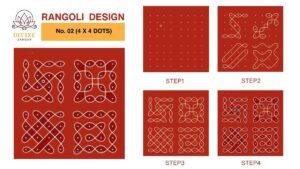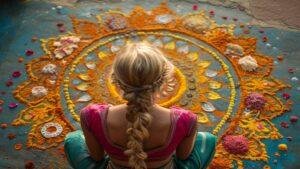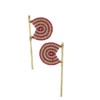India is the birthplace of the lovely art form known as rangoli, which employs a multitude of materials to fashion exquisite designs on tables and floors. Rangolis serve as a means of establishing a spiritual connection with the divine through art, not only as decoration. Diya Delight Rangoli might take the form of geometric forms, flowers, or petals, depending on the occasion. It is also possible to include religious symbols in the designs. Typically, rice or flour is used as the basis material for Rangoli, and it is combined with salt, turmeric, and other natural colors. A more contemporary version that can be quite eye-catching and appealing is chemical coloring. Additional materials for flower rangoli designs include red brick, colorful sand, and even flower petals.
How can one create homemade rangoli colors?
Rangoli, particularly during festivals, is a vibrant way to capture the essence of India. If you’re worried about your hand when creating free-hand rangoli creations or if you’re worried about the security of your kids and pets at home. When using chemical-free and environmentally safe materials, you can create the most beautiful Rangoli designs.
1. Yellow:
In your recipe, combine rice flour and turmeric powder in equal amounts. This will contribute to giving it a little crisp texture and a bright color. Well-mix to achieve the desired texture. This goes really well with rice.
2. Orange:
Bring a ton of marigold flowers and orange peel. Grind them together after letting them dry in the sun. Create stunning patterns by combining orange rangoli powder.
3. White:
It is not hard to make a white rangoli; in fact, a lot of people manage to accomplish it successfully with no trouble at all. This dish only calls for rice. All you have to do is powder the rice.
4. Black:
A distinctive hue that is uncommon to find in stores is black rangoli. It takes whitestone powder and non-toxic black ink to manufacture this black rangoli powder. Over the powder, pour the ink and stir thoroughly. Till the white becomes black, keep adding ink. Now you have it! Your designs might make use of the lovely black hue that you have.

5. Magenta:
When attempting to construct designs, magenta rangoli powder is a terrific technique to produce stunning designs. You can use dried beetroot flakes to make the powder. Really, there isn’t much more to it.
6. Vermilion:
Pomegranate and carrot peels must be dried and ground in order to release their red and orange hues. Additionally, you can embellish your arrangement with dried rose and hibiscus petals. Combine these materials in a grinder to make red rangoli powder.
7. Green:
All you have to do to acquire the color of green rangoli is grind some dried coriander, spinach, or other green leaves.
8. Brown:
It’s simple to create a Brown rangoli color. Just finely powder some cinnamon sticks.
9. Mix color:
Choose a mix color if you can’t decide on a hue of red. Simply dry and ground rose petals of various shades.
10. Purple:
To make purple rangoli powder at home, start with dried lavender flowers. To achieve a purple hue in the absence of lavender, combine jamun juice with coarse salt or rice powder.
How can one create homemade rangoli stencils?
Step 1: On a thick piece of paper, draw a little rangoli design. Print out your design and follow the directions if you’re not very good at drawing.
Step 2: Remove the black portion with a sharp knife. Any blade will work, but we use old-fashioned shaving brushes.
Step 3: You’ll need poster or acrylic paints, or Rangoli powder colors, to make your cutout stencil.
Step 4: If you are creating a pattern, consider the spacing at this point and arrange the paper appropriately. Holding the paper firmly in your fingers, begin coloring.
Step 5: The design won’t appear flawless after you’re coloring it, but it will get close. Remove the earbuds and use them to wipe away extra pigment.
Step 6: Keep using the design and repeating it.
How to create a Diya Delight Rangoli with flowers and leaves?
– Sketch a small, straightforward rangoli on the ground.
– Arrange a few flowers in the central design.
– Create designs with a few loose petals.
– Define the rangoli design with a rose.
– Place leaves over the empty space.
Steps to Create a Diya Delight Rangoli
- Using chalk or a light color, create a 4 x 4 dot grid on a clean surface, making sure that each dot is equally spaced.

2. Starting with the foundation of the Diya in the middle two dots of the grid, connect the central dots to outline a basic Diya (lamp) shape.

3. Using neighboring dots, create smaller diya shapes surrounding the center diya. Make sure they face outward from the central diya and are positioned symmetrically.

4. To improve their visibility and definition, highlight the diya shapes with a contrasting hue.
5. To make the diya shapes stand out, fill them with rangoli colors that are vivid and dazzling. To get a realistic impression, use various colors for the flame and base.

In summary
Rangoli, a beautiful art form from India, uses various materials to create intricate designs on tables and floors. Depending on the festivities, rangoli designs might include geometric, floral, or petal shapes. For Diwali, people create basic Rangoli using powders, flowers, and other components. After removing the rangoli, you’ll discover that it has damaged the lovely flooring. You can clean the floor using various procedures. You can create the greatest Rangoli colors with non-toxic, eco-friendly ingredients. Nowadays, people often draw Rangoli on water with powder or use pre-made Rangolis during festivities. When used as a Diwali unique rangoli at home, this one can draw attention.



















Add comment